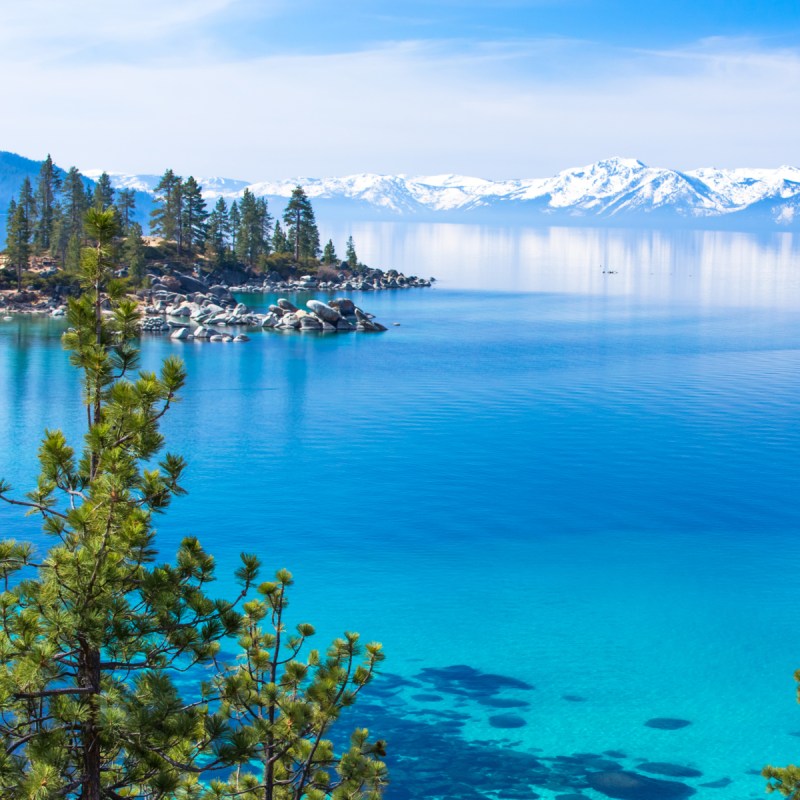
There is nothing quite like standing in front of an expanse of clear, shimmering blue water when it comes to witnessing some of the best Mother Nature has to offer. Visits to beautiful bodies of water can be some of the most moving, impactful moments of any vacation. From lakes in Croatia to a trench in Samoa, this is where you can see some of the bluest waters in the world.
Videos by TravelAwaits

Peyto Lake, Alberta, Canada
For a shimmering, stunningly blue lake, look no further than Alberta’s Peyto Lake. This natural freshwater lake, located in Canada’s Banff National Park, is the product of nearby melting glaciers. The glacier debris, known as rock flour, is composed of quartz and calcite, which alter the lake’s hue and give its whole surface a shimmering, glittering sheen. Visitors at Banff National Park should take Icefields Parkway onto the Bow Summit, where they can walk the Peyto Lake Trail and take in the gorgeous water.

Five-Flower Lake, Jiuzhaigou National Park, China
Five-Flower Lake is a body of water you have to see to believe. The water is so clear that it is entirely see-through, all the way to the bottom of the lake. Jiuzhaigou National Park is overflowing with beautiful lakes and waterfalls, but none of them can compete with the spectacularly blue water of Five-Flower Lake, where visitors can approach the water and look directly through its 16 feet depth. Depending on a visitor’s vantage point, the water may be a turquoise, sapphire blue, green, or even orange shade.

Plitvice Lakes National Park, Croatia
Croatia’s largest national park is home to not just one incredibly blue lake, but rather an entire lake system, encompassing 16 beautiful, uniquely blue lakes. Connected via waterfalls and paths both above and below ground, the lake system covers the national park’s 70,000 acres. Designated a national park in 1949 and a UNESCO World Heritage Site in 1979, the lakes are one of Croatia’s most popular tourist destinations, welcoming more than a million guests every year. With 16 lakes, 7 hiking trails, and 2 entrances, the park experience is customizable to every tourist.

Crater Lake, Crater Lake National Park, Oregon
Nearly 8,000 years ago, a volcanic eruption caused the collapse of a mountain peak, resulting in a still-standing crater. Filled with nothing more than rain and melted snow, Crater Lake is both the deepest lake in the country and — shockingly — often covered in clouds, rendering it invisible. The lake is 5 miles by 6 miles, with an average depth of 1,148 feet. On its visible days, the lake is a striking blue, shiny and pristine. Located in Crater Lake National Park, just witnessing it is a vacation highlight, among all the surrounding hiking, fishing, and skiing available.

Hanauma Bay, Oahu, Hawaii
Hanauma Bay is one of the most popular tourist destinations on the island of Oahu, and for good reason. The curved bay is home to an incredible collection of marine life, making it a favorite for snorkeling. The name derives from Hana, the Hawaiian word for “bay,” and uma, a reference to the curves of indigenous people’s canoes. In an effort to conserve the bay’s natural beauty, visitors must make reservations ahead of time for one of the few hundred tickets available every day. Take in the beauty of the island’s blue waters, while also learning about local conservation efforts and going snorkeling off the coast.

Lake Tahoe, California/Nevada
This large freshwater lake sits on the border of California and Nevada, spanning 22 miles long and stretching 12 miles wide. With a depth of 1,645 feet, Lake Tahoe is the 10th deepest lake in the world. Surrounded by the beautiful Sierra Nevada mountains, almost half of the Tahoe Basin’s rain and snow land directly in the lake, contributing to its clear blue waters.

To-Sua Ocean Trench, Samoa
There’s a reason thousands of visitors a year make the trek to the most famous natural swimming pool in Samoa. To-Sua, which translates to big hole, is natural saltwater, blue as can be. Visitors access the swimming hole by hiking cliffside paths, where they then have the option of either climbing down the provided ladder or — for the more adventurous — taking a jump from the top of the cliff into the nearly 100-foot-deep water. Swimmers can then exit the pool through a cave-like trench that opens directly into the ocean.
